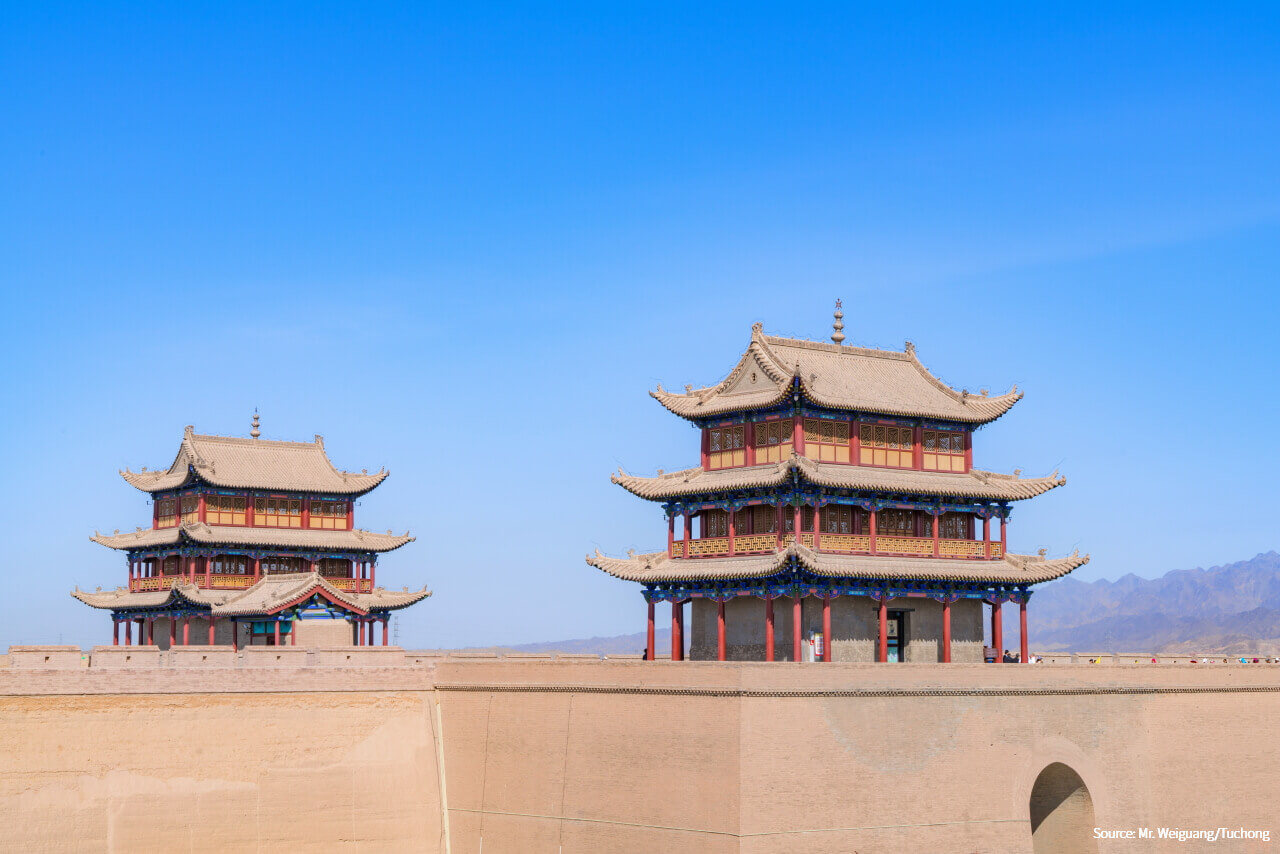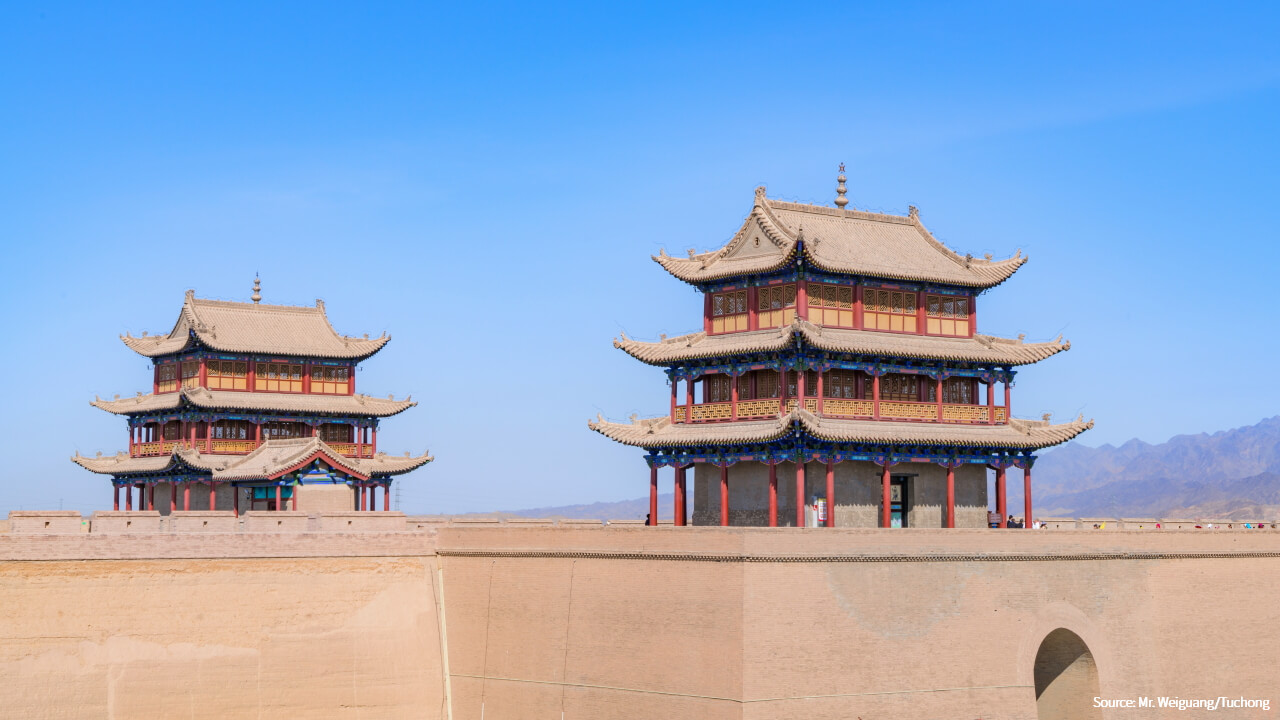
Jiayuguan Fort

Name in Chinese: 嘉峪关 Jiā Yù Guān [dʒa:ju:gwæ]
Duration of Tour: Two or Three Hours
Location: Yuquan Town, Jiayuguan Prefecture, Gansu Province
Highlights: the History of the Great Wall, the Dramatic Landscape of the Gobi Desert
Must-see Sightseeing Spots: the Outer Rampart, the Inner Rampart and the Great Wall Museum
Reputations: the No.1 Pass of the Great Wall, a National Five-star Scenic Area, a National Key Historical and Cultural Relic Site under Protection
Jiyuguan Fort is well-known as the No.1 Pass of the Great Wall or the Most Magnificent Fort under Heaven. It can be dated back to the year of 1372. The ancient fort covers an area of 2.5 hectares(6.17 acres). It is a complex, consisting of towers, ramparts and some other military buildings. The fortress town is enclosed by two ramparts, namely the outer rampart and the inner rampart. Visitors can climb up the walkways to the top of the ramparts and the Great Wall.
The Outer Rampart
The outer rampart is 13.4 meters(44 feet) in height and 733 meters(2,405 feet) in circumference. It connects the fort with the Great Wall. There are some old building enclosed by the outer rampart, such as Wenchang Pavilion, the Old Theatre and Guandi Temple.
Wenchang Pavilion can be traced back to the Ming Dynasty. The present building was reconstructed in 1822, the second year of Emperor Daoguang’s reign. It used to be a book club for local scholars during the Ming Dynasty. Later on, the building was changed into an office for local officials.
The Old Theatre was built in 1792, the fifty-seventh year of Emperor Qianlong’s reign. It was the place where the Qing’s servicemen and local people watched operas. A wooden screen divides the theatre into two parts, including the platform and the backstage. There are some beautiful mural paintings on the screen. The images are the eight of well-known immortals of Taoism.
Guandi Temple was rebuilt by the end of Ming Dynasty. The image of Guanyu is placed inside for worship. Guan Yu was a general of the Shu Kingdom(221-263). Since the general was a brave man and remained unshaken in his loyalty to his king, he has been widely respected by Chinese people for 1,800 years.
The Inner Rampart
The inner rampart is 10.7 meters(35 feet) in height and 640 meters(2,100 feet) in circumference. There are two gates built along the inner rampart. Both are huge gate towers. The west gate is named as “Rou-Yuan”, meaning “to make the borders stable and peaceful by mollifying the locals”. There is a horizontal board on the top of the east gate. The name of the gate is inscribed on the board, “Guang-Hua”. It means that the land would have been always illuminated by the sun. A tower stands on the west gate with a height of 17 meters(56 feet). It was built in the year of 1506.
The Great Wall Museum
The Great Wall Museum is situated in the ancient fort. It was founded in the year of 2003. The museum houses over 7,000 historical curiosities. Visitors can learn much about the history of the Great Wall and Jiayuguan Fort in the museum.
Nearby Scenic Areas
The Overhanging Wall
The Overhanging Wall is called Xuanbi Wall in Chinese. As a section of the Great Wall, it lies about 8 kilometers(5 miles) away from Jiayuguan Fort. The wall is built on a lofty ridge with an incredibly steep gradient. It looks like an cantilever sticking out the ridge.
The No.1 Earth-Pier of Great Wall
The earth-pier is a huge mound of earth. It stands as a remaining relic of the westernmost end of the Great Wall which was constructed in the Ming Dynasty. The mound of earth can be dated back to the fifth year of Emperor Zhu Yuanzhang’s reign(1372).
Opening Hours
8:30a.m.---6:00p.m.
Suggested Itineraries:
Related Articles:
Author: Tina Luo
Update:

Jiayuguan Fort